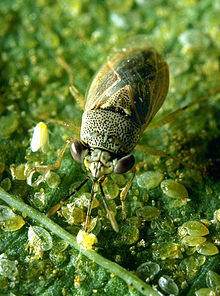Tobacco attracts predators with chemicals in response to caterpillars, a study finds
Monday, August 30, 2010

Ian Baldwin, of the Max Planck Institute for Chemical Ecology in Jena, Germany, and colleagues have discovered a multi-step protective mechanism of tobacco plants against Manduca sexta caterpillars. In response to a chemical in the caterpillars' larvae, the plants release an odorous substance into air to attract another species of insects, called "big-eyed bugs" (Geocoris). These carnivores come to the scene and attack the caterpillars. The response is triggered within 24 hours, which is a relatively short period of time. The discovery occurred as a result of field studies in a nature preserve in southwestern Utah.
The phenomenon starts with the recognition of the caterpillars by the plant. As a PhD student in the Department of Molecular Ecology Silke Allmann explained, "The plant cannot see its attacker, but plants can sense the digestive substances that attacking larvae have in their oral secretions when these substances come into contact with the leaves." To test that, the scientists coated some of caterpillars' eggs on two groups of tobacco plants and glued them. On one of the groups, the glue was mixed with caterpillars' split. The latter got more attention of the attackers, getting 25% of eggs destroyed against 8% for the other group.
Allmann supposed that "The simplest assumption is that the larval oral secretions contain a special enzyme, probably an isomerase, which rearranges the Z:E ratio of the aldehyde in favor of (E)-2-hexenal." The researchers heated the oral secretion to destroy the enzyme, and applied it to wounded leaves. No plant response related to the studied process was observed, confirming the hypothesis.
(E)-2-hexenal is a strong antibiotic agent. The food consumed by a caterpillar typically includes hundreds of microorganisms together with leaf tissue, which are mostly unneeded and killed by the above-mentioned substance quickly. Because of this important role of this substance, the caterpillars can't change their metabolism easily enough to prevent the subsequent events from happening.

Image: Jack Dykinga.
To find out what happens after a caterpillar's presence is noted by the plant, Silke Allmann, a graduate student in Baldwin's group, examined the green leafy volatiles (GLVs), the substances responsible for the smell of fresh-cut plant parts. These substances are released into air if a plant is damaged. As the study released, the tobacco plant GLVs typically have a major share of Z isomers with very small amount of E isomers present. But the shares are distributed equally during a caterpillar attack. In a study with varying amount of different isomers present, E isomers turned out to be the ones attracting the predators to come to the scene and to attack the caterpillars.
What is surprising, Silke Allmann found that the caterpillars are the direct stimulus of this change: caterpillar saliva converts the Z-isomers of the GLV molecules to E-isomers. Prof. Ian Baldwin commented, "That's where it got really weird. Why would a caterpillar do this to itself?" He suggested that the E-GLVs could have anti-biotic effect in the caterpillar's digestive system.
The speed of the triggered reaction is relatively fast, it taking about one hour for the GLV isomers ratio change, and about 24 hours for the predators to be attracted by the substance released into the air. As Prof. Ian Baldwin, who was leading the research, said, "Other indirect defense mechanisms of plants require the activation of new metabolic pathways for the release of odorant signals, and these responses are much slower."
The multi-step intricate approach involved is attracting the attention of scientists, who are looking forward to its application in agriculture. Baldwin noted that "in effect, the caterpillar calls the police on itself", and suggested to genetically modify crops to release similar signals to defend themselves against pests.
Sources
- Victoria Gill. "Plants send SOS signal to insects" — BBC News, August 27, 1010
- Michael Marshall. "Tobacco plants outsmart hungry caterpillars" — New Scientist, August 26, 1010
- Helen Fields, ScienceNOW. "Caterpillars Sign Their Own Death Warrants" — American Association for the Advancement of Science, August 26, 1010
- "Lethal backfire: Green odor with fatal consequences for voracious caterpillars" — PhysOrg, August 26, 1010
- "The smell of freshly-cut grass is actually a plant distress call" — io9, August 26, 1010
External links
- Silke Allmann and Ian T. Baldwin (2010). "Insects Betray Themselves in Nature to Predators by Rapid Isomerization of Green Leaf Volatiles". Science. doi:. http://www.sciencemag.org/cgi/content/abstract/329/5995/1075.
